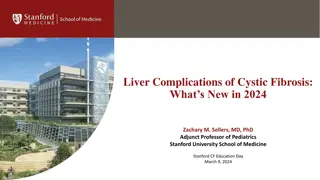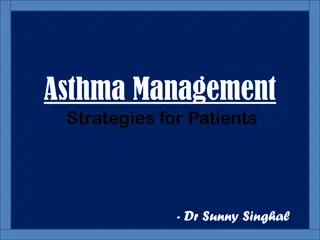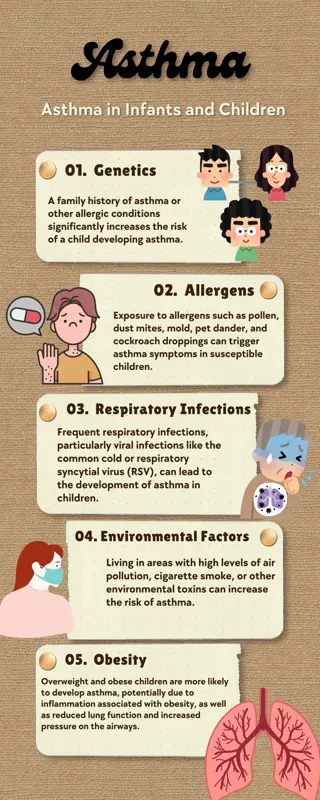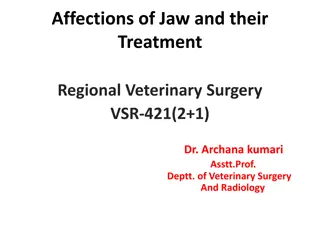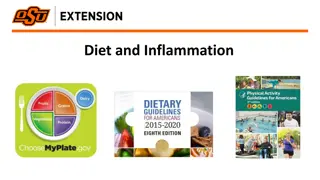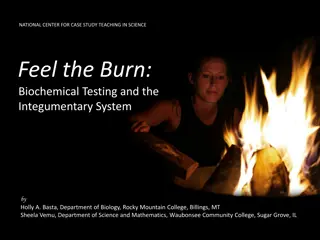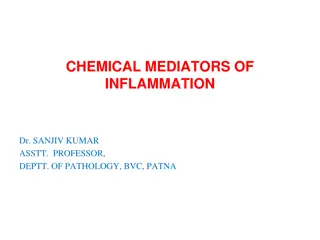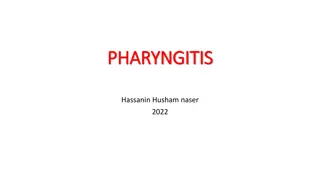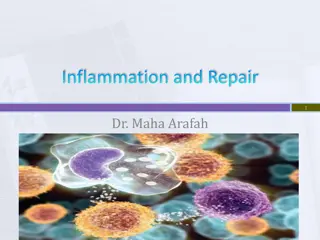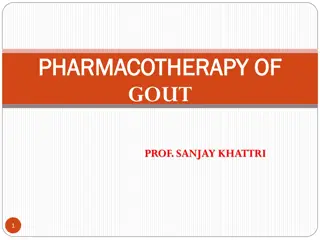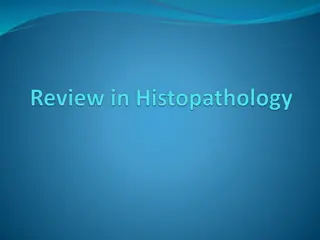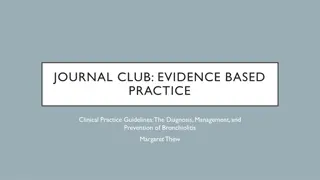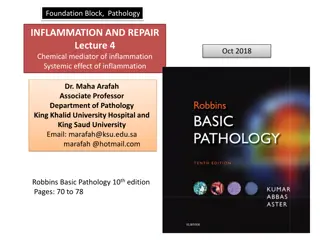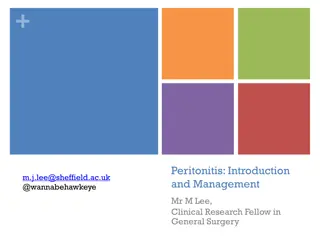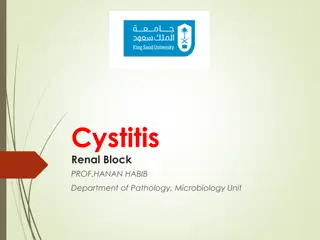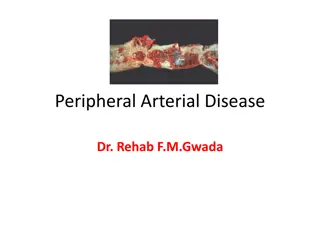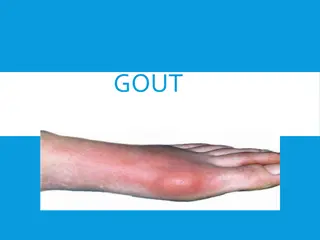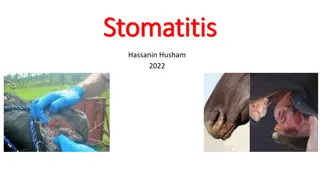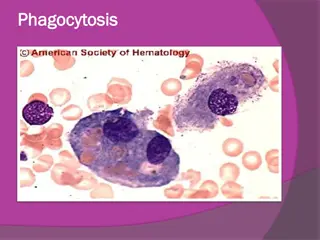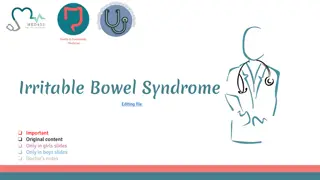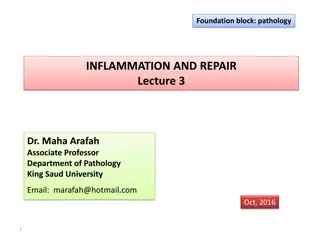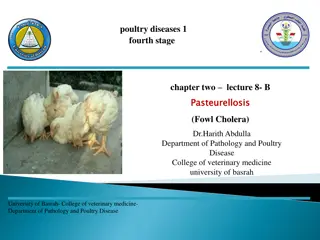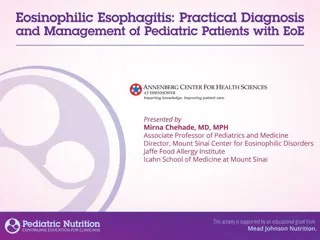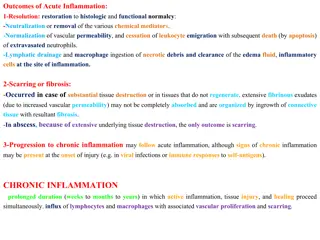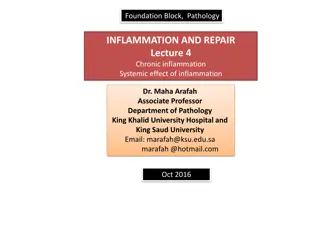Inflammation and Cholesterol Predicting Cardiovascular Events
This study explores how inflammation and cholesterol levels predict cardiovascular events among 13,970 statin-intolerant patients in the CLEAR Outcomes trial. Findings suggest residual inflammatory risk may be a stronger predictor than residual cholesterol risk for future events. The research analyz
0 views • 17 slides
Understanding Spondylodiscitis: Diagnosis, Treatment, and Prognosis
Spondylodiscitis is an infectious inflammation affecting the spine's discs and adjacent vertebrae, posing challenges due to potential complications like abscess formation. Early diagnosis and prompt treatment are crucial for a favorable outcome, focusing on infection eradication, pain management, de
0 views • 22 slides
Understanding Cholecystitis and Cholelithiasis: Causes, Risk Factors, and Management
Inflammation of the gallbladder (cholecystitis) and the presence of stones in the gallbladder (cholelithiasis) are common conditions. Acute cholecystitis is often caused by gallstones, while chronic cholecystitis can result from repeated attacks or chronic irritation. Risk factors include gender, ag
2 views • 21 slides
Understanding Liver Complications in Cystic Fibrosis: Latest Insights for 2024
Liver complications in cystic fibrosis (CF) have gained importance due to CFTR modulators impacting liver health. This presentation by Dr. Zachary M. Sellers delves into new definitions for CF liver disease, CFF recommendations for screening, management, and treatment of hepatobiliary issues in CF.
0 views • 17 slides
Nursing Care for Ventilator-Associated Pneumonia (VAP)
Ventilator-Associated Pneumonia (VAP) is defined as lung parenchyma inflammation occurring 48 hours or more after endotracheal intubation and mechanical ventilation initiation. It is a common nosocomial infection in ICU patients, with significant morbidity and mortality rates. Etiology of VAP involv
2 views • 24 slides
Asthma Management
Asthma is a chronic respiratory condition characterized by inflammation and narrowing of the airways, leading to symptoms like wheezing, coughing, shortness of breath, and chest tightness. Triggers vary and can include allergens, exercise, cold air, and stress. Effective management involves avoiding
1 views • 6 slides
Asthma
Asthma in infants and children is a chronic condition characterized by inflammation and narrowing of the airways, causing difficulty in breathing, wheezing, and coughing. Triggers include allergens, respiratory infections, and environmental factors. Early diagnosis and management are crucial for imp
1 views • 1 slides
Start Your Healthcare Career_ CNA Online Course by CNA
Open a new chapter in your life, and work towards filling a vital niche in the growing healthcare sector. You should check a course like the CNA online course provided by CNA.School if you are in need of such a class. This Course will equip you with all imaginable knowledge and practical skills that
1 views • 3 slides
Understanding COX Enzymes and Their Impact on Pain and Inflammation
COX enzymes, including COX1, COX2, and COX3, play a crucial role in synthesizing prostanoids like prostaglandins in the body, affecting pain and inflammation. By inhibiting these enzymes, relief from pain and inflammation can be achieved. However, non-selective COX inhibitors may lead to various sid
0 views • 21 slides
Veterinary Management of Jaw Affections and Treatments
Affections of the jaw in animals can range from congenital conditions to inflammatory diseases like gnathitis and lymphadenitis. Paralysis of the lower jaw, gnathitis from bit injuries, and lymphadenitis are discussed, along with their etiology, clinical signs, and treatment options such as general
0 views • 20 slides
Understanding the Link Between Diet, Inflammation, and Chronic Diseases
Inflammation is the body's natural response to injury, infection, or attack, but chronic low-grade inflammation can lead to various diseases. The immune system plays a crucial role in protecting the body against harmful substances. Chronic diseases like obesity, diabetes, and cancer often have under
1 views • 17 slides
Burn Injury Complications and Treatment: A Case Study
Alison, a young woman with a burn foot injury, undergoes skin grafting which leads to inflammation and bacterial infection. Despite antibiotic treatment, she develops bacteremia and an abscess. The case study explores burn degrees, skin layers, graft types, inflammation causes, bacterial identificat
1 views • 11 slides
Overview of Chemical Mediators of Inflammation and Their Roles
Chemical mediators of inflammation act on blood vessels and cells to contribute to an inflammatory response. These mediators include vasoactive amines like histamine and serotonin, plasma proteases such as the complement, kinin, and clotting systems, and important inflammatory mediators like C3a and
1 views • 24 slides
Understanding Pharyngitis: Causes, Symptoms, and Management
Pharyngitis is an inflammation of the pharynx characterized by coughing, painful swallowing, and appetite changes. It can be caused by physical or infectious factors, leading to symptoms such as virtual obstruction, regurgitation, and drooling. Understanding the etiology and pathogenesis is crucial
1 views • 32 slides
Understanding Inflammation and Its Characteristics
Inflammation is the response of tissues to harmful agents, categorized as acute or chronic. Acute inflammation is rapid and short-lived, while chronic inflammation is insidious and prolonged. Chemical mediators play a crucial role in both forms, leading to tissue necrosis. The five cardinal signs of
3 views • 27 slides
Understanding Cellular Events in Inflammation and Repair
Explore the lecture on Cellular Events in Inflammation by Dr. Maha Arafah, focusing on the sequence of vascular changes in acute inflammation, phases of changes in vascular caliber and flow, and objectives covering leukocyte extravasation, chemotaxis, phagocytosis, and microbial killing. Reference m
0 views • 47 slides
Understanding Inflammation and Repair in Tissue Response
Inflammation is a crucial process in response to tissue injury, aiming to eliminate harmful agents and promote healing. It involves vascular changes, increased permeability, and the formation of edema. Repair follows inflammation, involving regeneration and fibroblastic tissue formation. While infla
0 views • 57 slides
Understanding Gout: Pathophysiology and Pharmacotherapy Overview
Gout is a condition caused by the accumulation of urate crystals, leading to inflammation and various symptoms like acute arthritis and joint destruction. This article delves into the pathophysiology of gout, highlighting factors like hyperuricemia and crystal formation. It also discusses pharmacoth
2 views • 30 slides
Understanding Safety Protocols and Inflammation in Histotechnique Laboratory
Safety in the histotechnique laboratory is crucial to prevent exposure to infectious agents like prions. Proper decontamination methods, such as formalin and formic acid treatment, are essential for handling tissues from suspected patients. Additionally, precautions should be taken to avoid airborne
0 views • 97 slides
Evidence-Based Guidelines for Bronchiolitis in Children: Diagnosis, Management, and Prevention
Bronchiolitis is a common viral illness in infants characterized by lower respiratory tract inflammation. The American Academy of Pediatrics released updated guidelines in 2015 for children aged 1-23 months, focusing on evidence-based approaches for diagnosis, prevention, and management. The guideli
3 views • 30 slides
Chemical Mediators of Inflammation: Understanding Sources and Effects
Chemical mediators of inflammation play a pivotal role in inducing specific events during acute inflammation. These mediators are produced in response to various triggers, including microbial products and host proteins, leading to a cascade of inflammatory responses. Understanding the sources and ef
1 views • 43 slides
Understanding Peritonitis: Causes, Symptoms, and Management
Peritonitis is inflammation of the peritoneum, often caused by bacterial infections or other factors like bile leaks or ruptured ectopic pregnancies. Recognizing the signs, such as sudden abdominal pain and tenderness, is crucial for early diagnosis and treatment. Effective management involves treat
0 views • 26 slides
Understanding Nephritis: Causes, Symptoms, and Subtypes
Nephritis is a serious medical condition characterized by inflammation of the nephrons in the kidneys. This inflammation can lead to various subtypes such as glomerulonephritis and interstitial nephritis, each with its own causes and symptoms. Common symptoms of nephritis include edema, changes in u
0 views • 26 slides
Understanding Cystitis: Causes, Symptoms, and Management
Cystitis is a common urinary tract infection affecting both men and women, characterized by inflammation of the bladder mucosa. This article covers the definition, pathogenesis, risk factors, causative organisms, types, diagnostic methods, and treatment options for cystitis, emphasizing the importan
0 views • 24 slides
Understanding Peripheral Arterial Disease (PAD) - Overview and Management
Peripheral Arterial Disease (PAD) refers to the narrowing of blood vessels outside the heart and brain, leading to reduced blood flow. This condition can result from atherosclerosis, inflammation, embolism, or thrombus formation. Learn about the causes, symptoms, diagnosis, and treatment strategies
5 views • 34 slides
Integrative Approaches to Pediatric Pain Management: A Comprehensive Review
Pediatric pain management is a complex issue involving factors such as inflammation, neuroplasticity, and emotional responses. Dr. Matthew Hand explores integrative approaches to address common pediatric pain conditions and highlights the prevalence of chronic pain in children. The presentation delv
0 views • 39 slides
Role of REG3 and I-FABP in HIV-Related Gut Permeability and Inflammation
This presentation highlights the significance of Regenerating Islet-Derived Protein-3 (REG3) and Intestinal Fatty Acid Binding Protein (I-FABP) in microbial translocation, inflammation, and reservoir size in individuals living with HIV. REG3 and I-FABP serve as markers of gut epithelial damage and p
0 views • 7 slides
Understanding Gout: Causes, Symptoms, and Management
Gout is a condition caused by excessive uric acid levels in the blood, leading to crystal deposits in joints and tissues, resulting in intense pain, inflammation, and redness. Commonly seen in the first metatarsophalangeal joint, gout can present with joint changes and decreased mobility. Recognizin
0 views • 26 slides
Understanding Stomatitis: Causes, Symptoms, and Management
Stomatitis is the inflammation of the oral mucosa, involving conditions like glossitis, palatitis, and gingivitis. It can be caused by physical, chemical, or infectious agents. Trauma, irritant drugs, and various infections contribute to this condition. Recognizing the etiology and factors contribut
0 views • 16 slides
Understanding Phagocytosis, Inflammation, and Granulomas in Tuberculosis
Phagocytosis is a crucial process where cells engulf and digest pathogens. Inflammation responses involve various immune cells like neutrophils, plasma cells, lymphocytes, and macrophages. Granulomas, typical in diseases like tuberculosis, are mass accumulations in chronic inflammation. Tuberculosis
0 views • 18 slides
Risk Management & MPTF Portfolio Analysis at Programme Level for UN Somalia
This session delves into the world of risk management and portfolio analysis at the programme/project level, specifically focusing on the Risk Management Unit of the United Nations Somalia. It covers enterprise risk management standards, planned risk management actions, the role of RMU, joint risk m
0 views • 30 slides
Understanding Dry Eye Disease: Causes, Symptoms, and Management
Dry eye disease is a common condition caused by factors leading to inflammation of the eye and tear-producing glands, affecting tear production and eye lubrication. This presentation covers the definition, clinical features, and management of dry eye, emphasizing its impact on quality of life and im
0 views • 67 slides
Understanding Irritable Bowel Syndrome: Pathophysiology, Symptoms, and Management
Irritable Bowel Syndrome (IBS) is a common gastrointestinal condition with uncertain pathophysiology involving factors like motility, hypersensitivity, inflammation, and gut microflora. Symptoms include abdominal pain, altered bowel habits, and bloating. Diagnosis is based on Rome IV criteria, and m
0 views • 9 slides
Understanding the Outcomes and Patterns of Inflammation in Pathology
The lecture by Dr. Maha Arafah delves into the outcomes and patterns of acute inflammation, discussing outcomes like complete resolution, fibrosis, chronic inflammation progression, and abscess formation. It also covers chemical mediators, morphologic patterns, and events in inflammation resolution,
0 views • 50 slides
Principles and Management of Acute Liver Disorders by Consultant Hepatologist
This presentation discusses the principles, causes, presentations, management, and prognosis of acute liver disorders, with a focus on insult to the normal liver leading to liver injury, inflammation, and necrosis. It covers causes such as drugs, viruses, ischemia, autoimmune conditions, Budd-Chiari
0 views • 16 slides
Understanding Pasteurellosis (Fowl Cholera) in Poultry: Causes, Symptoms, and Management
Pasteurellosis, also known as Fowl Cholera, is an acute septicemic disease affecting domestic fowl and wild birds caused by Pasteurella multocida. This disease is characterized by high morbidity and mortality rates, primarily impacting chickens, turkeys, and ducks. The disease spreads through health
0 views • 10 slides
Understanding Eosinophilic Gastrointestinal Diseases in Pediatric Patients
This educational material covers the clinical presentation, causes, allergic histopathology, immunopathogenesis, and management options for pediatric patients with eosinophilic esophagitis (EoE). Expert insights are provided on defining EoE, discussing etiology, diagnosing EoE, demographics, and the
0 views • 63 slides
Dr. Reckeweg R1 Inflammation Drop 8600777555
\n\n Dr. Reckeweg R1 Inflammation Drop 8600777555 \nA solid clinical expert, Shivam Homeopathic Pharmacy in Viman Nagar, Pune is one among the saw Homeopathic Fix Retailers
1 views • 2 slides
Understanding Acute and Chronic Inflammation: Causes, Outcomes, and Resolution
Acute inflammation results in either resolution or progression to chronic inflammation, with outcomes like restoration of normalcy, fibrosis, or scarring. Chronic inflammation can be caused by viral infections, persistent microbial infections, exposure to toxic agents, or autoimmune diseases. Macrop
0 views • 27 slides
Overview of Chronic Inflammation: Causes, Effects, and Patterns
Chronic inflammation, a prolonged inflammatory process lasting weeks to years, involves a complex interplay of cells and tissue changes leading to fibrosis. This type of inflammation can arise from persistent infections by microbes or immune-mediated inflammatory diseases. Understanding the causes,
0 views • 41 slides



